MGT322 Assignment 3: Lean and Agile Supply Chain Management Report
VerifiedAdded on 2022/09/07
|9
|1582
|28
Report
AI Summary
This report delves into the core principles of logistics management, focusing on Lean Thinking and the Just-in-Time (JIT) concept. It explores how organizations adopt Lean Thinking to eliminate wasteful activities within the supply chain, thereby increasing product flow and speed. The report also examines the Agile Supply Chain, a strategy designed to quickly respond to changing customer demands. It identifies various types of waste that organizations must consider during production and analyzes the key functions of Lean Thinking, including production flow, planning, and organization performance measures. The report provides real-world examples and concludes by emphasizing the importance of implementing Lean management to improve quality and efficiency within a production enterprise. The report highlights the advantages of Lean Thinking, such as improved efficiency, better asset usage, and smarter methods. It also addresses the challenges of production errors and the need for hybrid supply chains to maintain competitiveness and security.
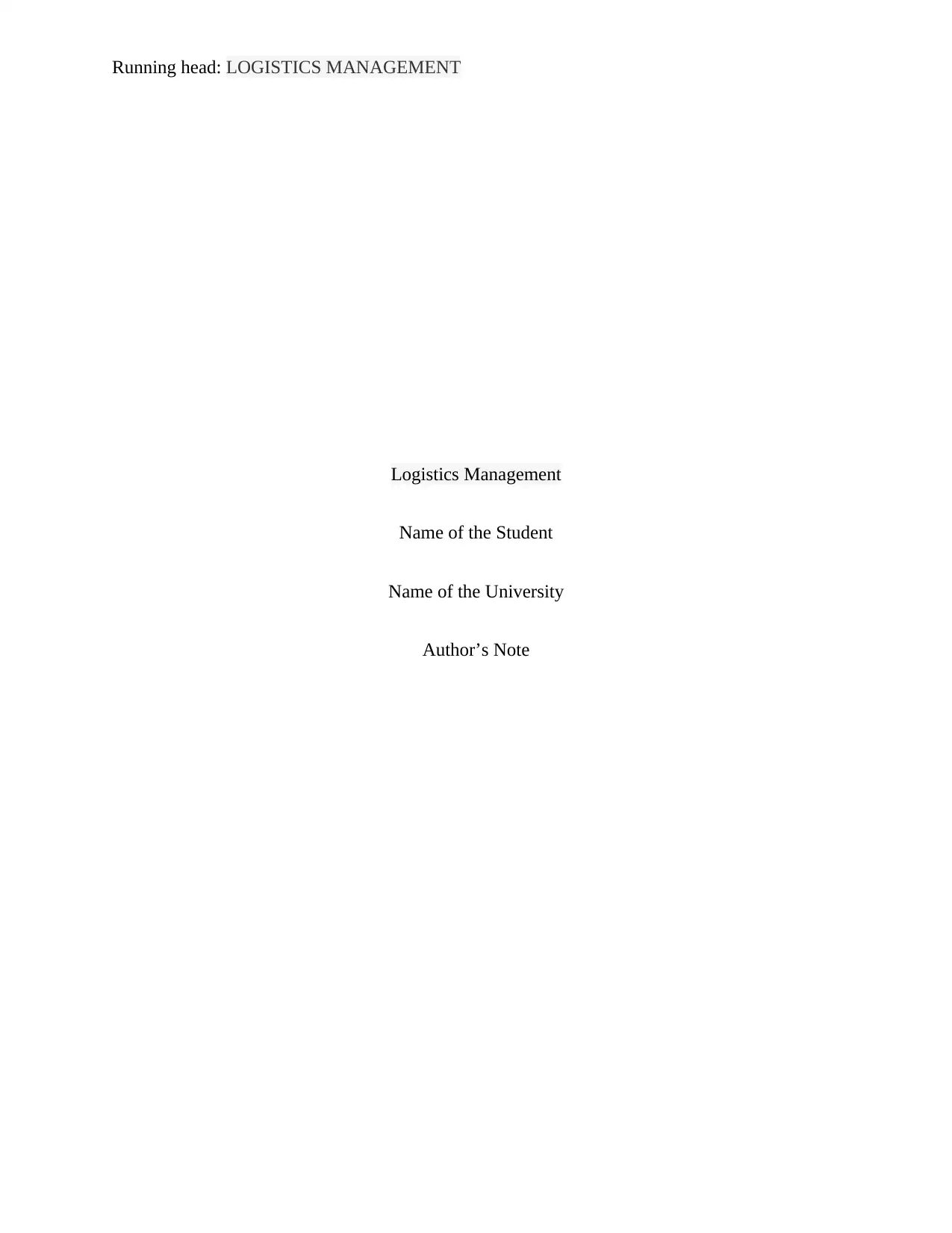
Running head: LOGISTICS MANAGEMENT
Logistics Management
Name of the Student
Name of the University
Author’s Note
Logistics Management
Name of the Student
Name of the University
Author’s Note
Paraphrase This Document
Need a fresh take? Get an instant paraphrase of this document with our AI Paraphraser
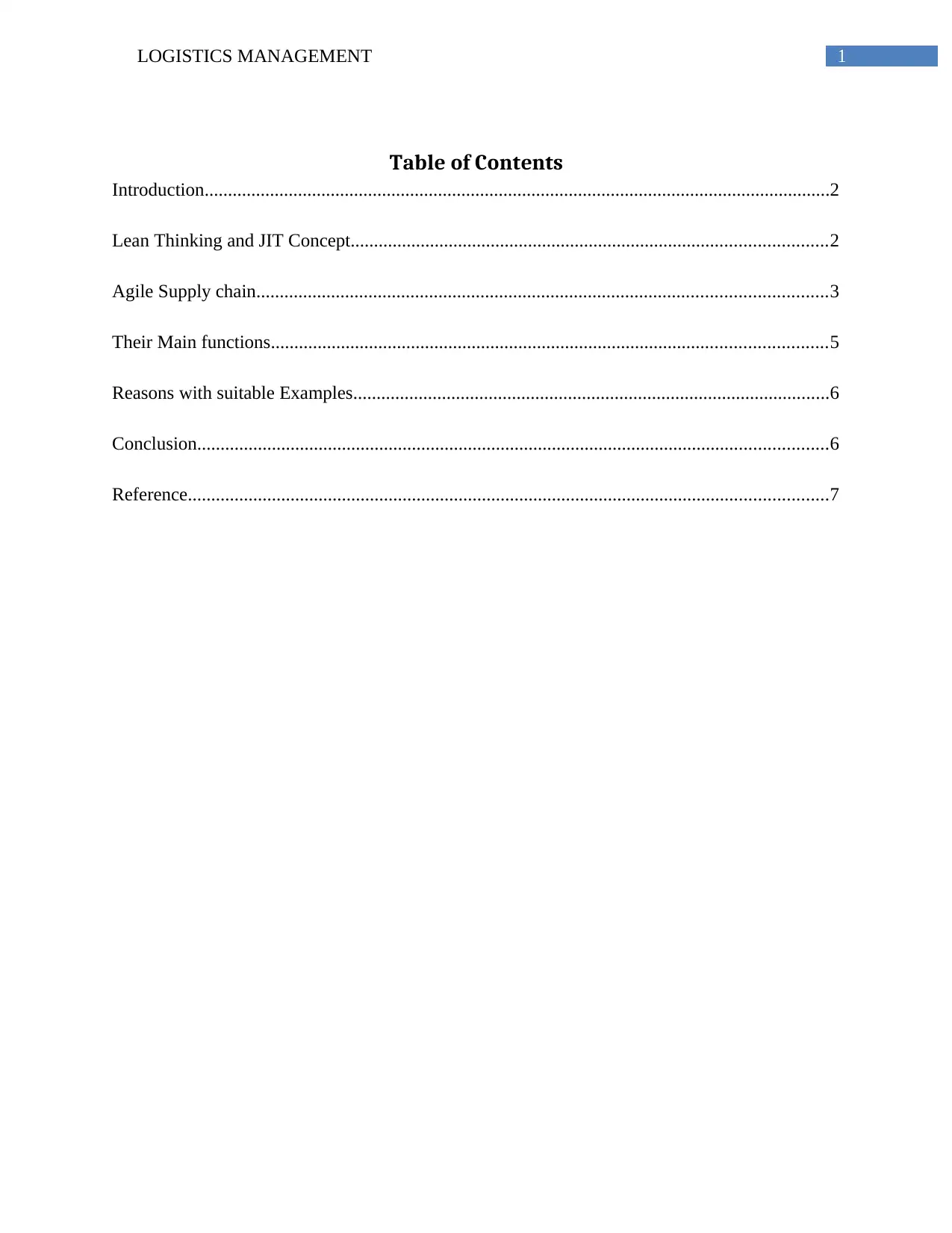
1LOGISTICS MANAGEMENT
Table of Contents
Introduction......................................................................................................................................2
Lean Thinking and JIT Concept......................................................................................................2
Agile Supply chain..........................................................................................................................3
Their Main functions.......................................................................................................................5
Reasons with suitable Examples......................................................................................................6
Conclusion.......................................................................................................................................6
Reference.........................................................................................................................................7
Table of Contents
Introduction......................................................................................................................................2
Lean Thinking and JIT Concept......................................................................................................2
Agile Supply chain..........................................................................................................................3
Their Main functions.......................................................................................................................5
Reasons with suitable Examples......................................................................................................6
Conclusion.......................................................................................................................................6
Reference.........................................................................................................................................7
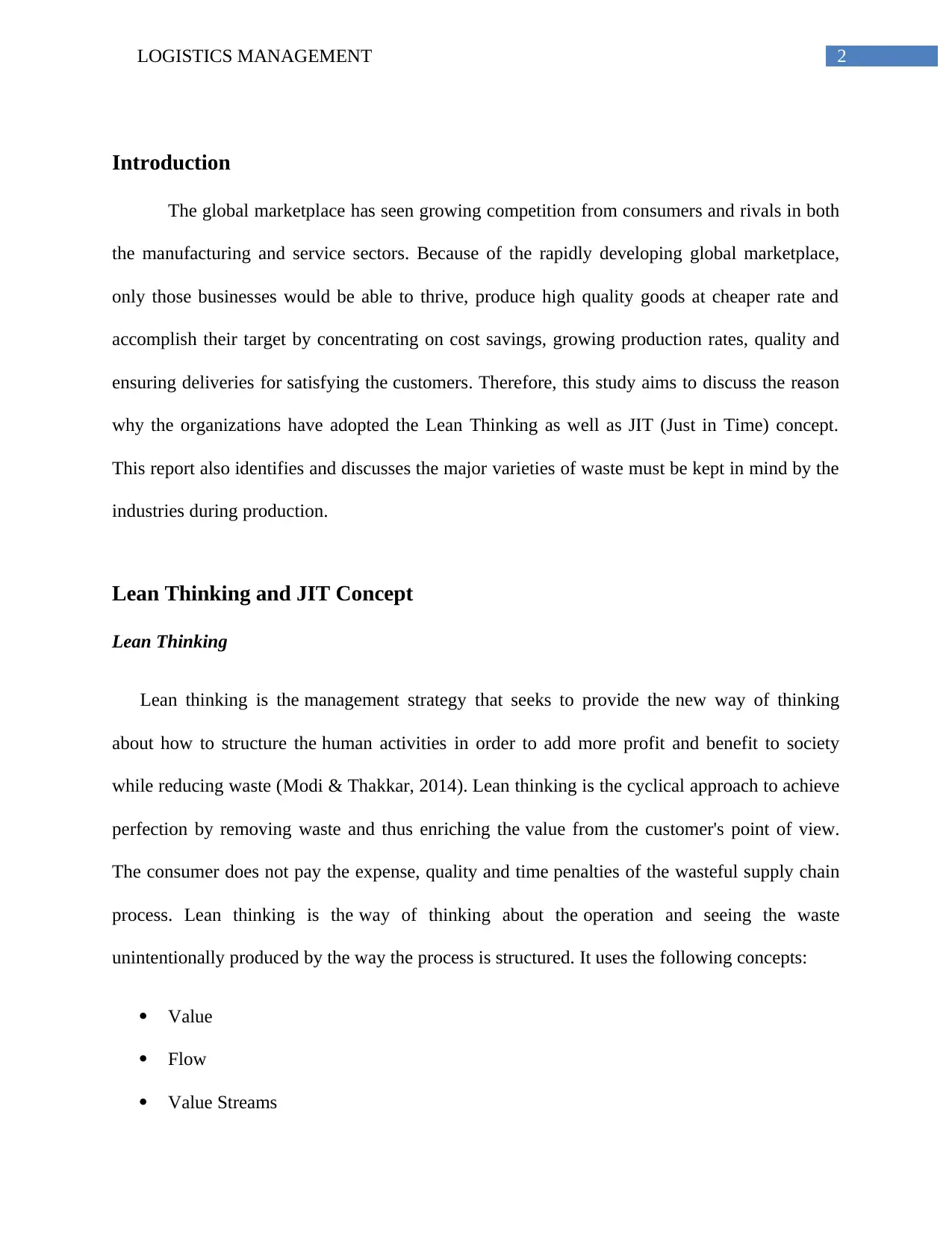
2LOGISTICS MANAGEMENT
Introduction
The global marketplace has seen growing competition from consumers and rivals in both
the manufacturing and service sectors. Because of the rapidly developing global marketplace,
only those businesses would be able to thrive, produce high quality goods at cheaper rate and
accomplish their target by concentrating on cost savings, growing production rates, quality and
ensuring deliveries for satisfying the customers. Therefore, this study aims to discuss the reason
why the organizations have adopted the Lean Thinking as well as JIT (Just in Time) concept.
This report also identifies and discusses the major varieties of waste must be kept in mind by the
industries during production.
Lean Thinking and JIT Concept
Lean Thinking
Lean thinking is the management strategy that seeks to provide the new way of thinking
about how to structure the human activities in order to add more profit and benefit to society
while reducing waste (Modi & Thakkar, 2014). Lean thinking is the cyclical approach to achieve
perfection by removing waste and thus enriching the value from the customer's point of view.
The consumer does not pay the expense, quality and time penalties of the wasteful supply chain
process. Lean thinking is the way of thinking about the operation and seeing the waste
unintentionally produced by the way the process is structured. It uses the following concepts:
Value
Flow
Value Streams
Introduction
The global marketplace has seen growing competition from consumers and rivals in both
the manufacturing and service sectors. Because of the rapidly developing global marketplace,
only those businesses would be able to thrive, produce high quality goods at cheaper rate and
accomplish their target by concentrating on cost savings, growing production rates, quality and
ensuring deliveries for satisfying the customers. Therefore, this study aims to discuss the reason
why the organizations have adopted the Lean Thinking as well as JIT (Just in Time) concept.
This report also identifies and discusses the major varieties of waste must be kept in mind by the
industries during production.
Lean Thinking and JIT Concept
Lean Thinking
Lean thinking is the management strategy that seeks to provide the new way of thinking
about how to structure the human activities in order to add more profit and benefit to society
while reducing waste (Modi & Thakkar, 2014). Lean thinking is the cyclical approach to achieve
perfection by removing waste and thus enriching the value from the customer's point of view.
The consumer does not pay the expense, quality and time penalties of the wasteful supply chain
process. Lean thinking is the way of thinking about the operation and seeing the waste
unintentionally produced by the way the process is structured. It uses the following concepts:
Value
Flow
Value Streams
⊘ This is a preview!⊘
Do you want full access?
Subscribe today to unlock all pages.

Trusted by 1+ million students worldwide
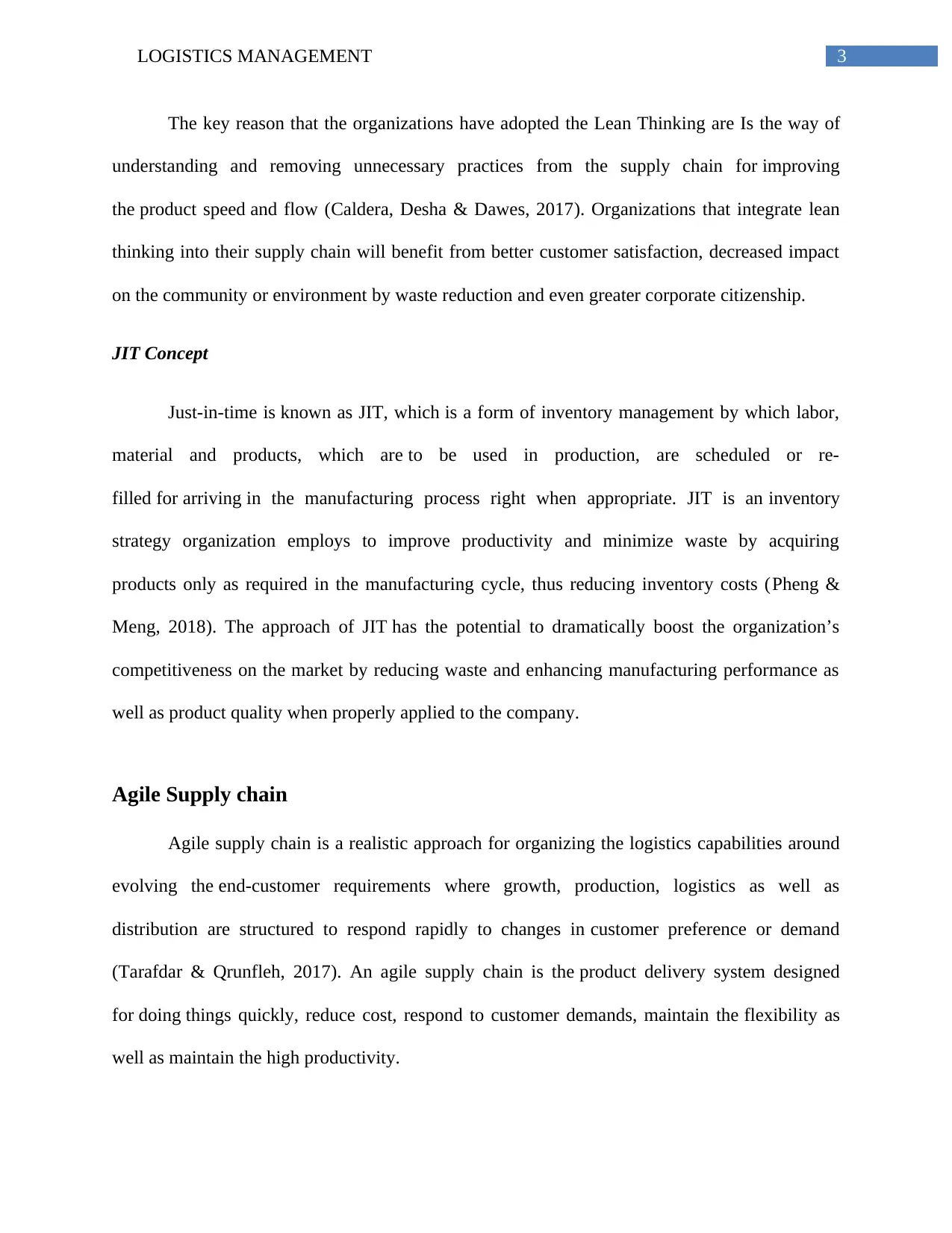
3LOGISTICS MANAGEMENT
The key reason that the organizations have adopted the Lean Thinking are Is the way of
understanding and removing unnecessary practices from the supply chain for improving
the product speed and flow (Caldera, Desha & Dawes, 2017). Organizations that integrate lean
thinking into their supply chain will benefit from better customer satisfaction, decreased impact
on the community or environment by waste reduction and even greater corporate citizenship.
JIT Concept
Just-in-time is known as JIT, which is a form of inventory management by which labor,
material and products, which are to be used in production, are scheduled or re-
filled for arriving in the manufacturing process right when appropriate. JIT is an inventory
strategy organization employs to improve productivity and minimize waste by acquiring
products only as required in the manufacturing cycle, thus reducing inventory costs (Pheng &
Meng, 2018). The approach of JIT has the potential to dramatically boost the organization’s
competitiveness on the market by reducing waste and enhancing manufacturing performance as
well as product quality when properly applied to the company.
Agile Supply chain
Agile supply chain is a realistic approach for organizing the logistics capabilities around
evolving the end-customer requirements where growth, production, logistics as well as
distribution are structured to respond rapidly to changes in customer preference or demand
(Tarafdar & Qrunfleh, 2017). An agile supply chain is the product delivery system designed
for doing things quickly, reduce cost, respond to customer demands, maintain the flexibility as
well as maintain the high productivity.
The key reason that the organizations have adopted the Lean Thinking are Is the way of
understanding and removing unnecessary practices from the supply chain for improving
the product speed and flow (Caldera, Desha & Dawes, 2017). Organizations that integrate lean
thinking into their supply chain will benefit from better customer satisfaction, decreased impact
on the community or environment by waste reduction and even greater corporate citizenship.
JIT Concept
Just-in-time is known as JIT, which is a form of inventory management by which labor,
material and products, which are to be used in production, are scheduled or re-
filled for arriving in the manufacturing process right when appropriate. JIT is an inventory
strategy organization employs to improve productivity and minimize waste by acquiring
products only as required in the manufacturing cycle, thus reducing inventory costs (Pheng &
Meng, 2018). The approach of JIT has the potential to dramatically boost the organization’s
competitiveness on the market by reducing waste and enhancing manufacturing performance as
well as product quality when properly applied to the company.
Agile Supply chain
Agile supply chain is a realistic approach for organizing the logistics capabilities around
evolving the end-customer requirements where growth, production, logistics as well as
distribution are structured to respond rapidly to changes in customer preference or demand
(Tarafdar & Qrunfleh, 2017). An agile supply chain is the product delivery system designed
for doing things quickly, reduce cost, respond to customer demands, maintain the flexibility as
well as maintain the high productivity.
Paraphrase This Document
Need a fresh take? Get an instant paraphrase of this document with our AI Paraphraser
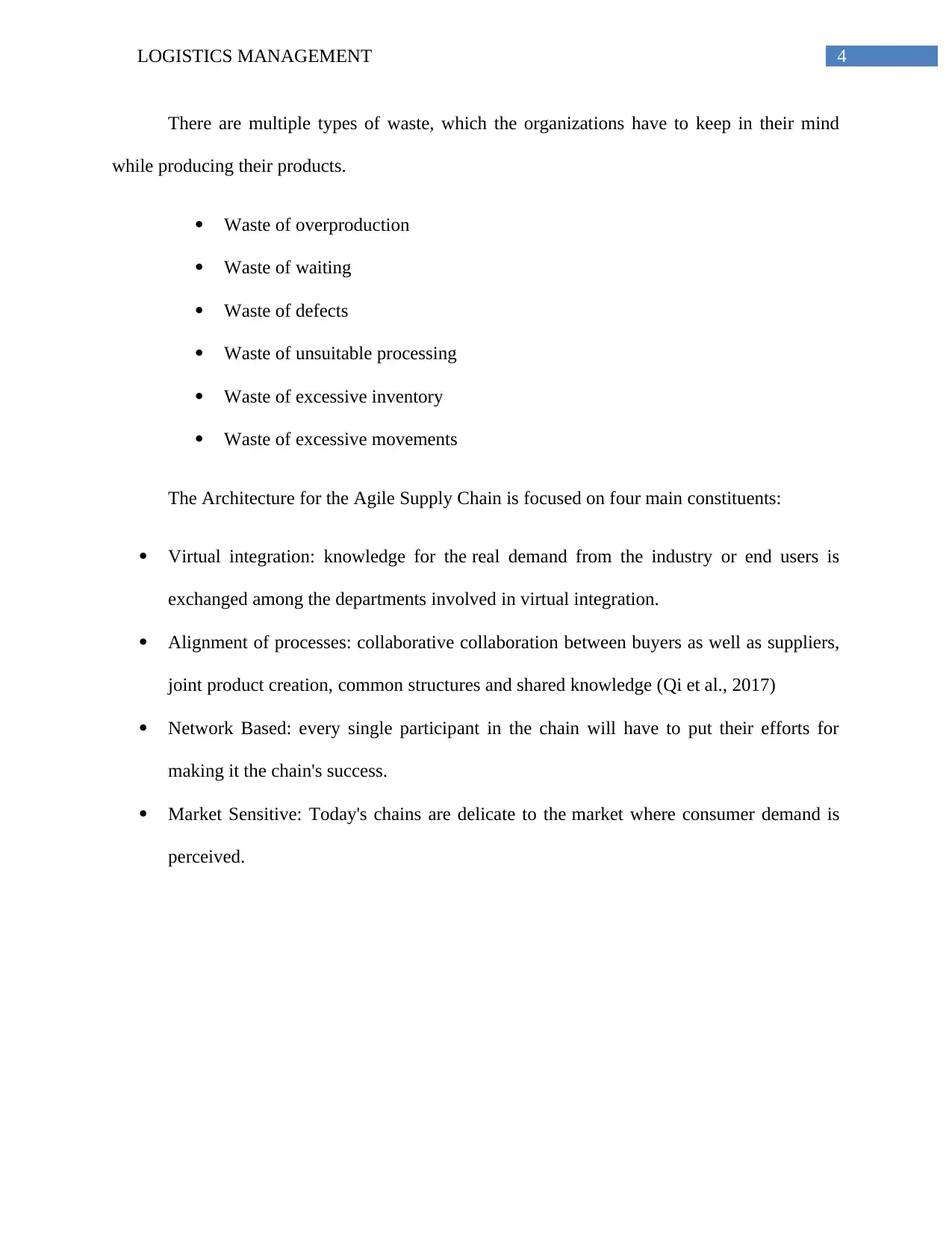
4LOGISTICS MANAGEMENT
There are multiple types of waste, which the organizations have to keep in their mind
while producing their products.
Waste of overproduction
Waste of waiting
Waste of defects
Waste of unsuitable processing
Waste of excessive inventory
Waste of excessive movements
The Architecture for the Agile Supply Chain is focused on four main constituents:
Virtual integration: knowledge for the real demand from the industry or end users is
exchanged among the departments involved in virtual integration.
Alignment of processes: collaborative collaboration between buyers as well as suppliers,
joint product creation, common structures and shared knowledge (Qi et al., 2017)
Network Based: every single participant in the chain will have to put their efforts for
making it the chain's success.
Market Sensitive: Today's chains are delicate to the market where consumer demand is
perceived.
There are multiple types of waste, which the organizations have to keep in their mind
while producing their products.
Waste of overproduction
Waste of waiting
Waste of defects
Waste of unsuitable processing
Waste of excessive inventory
Waste of excessive movements
The Architecture for the Agile Supply Chain is focused on four main constituents:
Virtual integration: knowledge for the real demand from the industry or end users is
exchanged among the departments involved in virtual integration.
Alignment of processes: collaborative collaboration between buyers as well as suppliers,
joint product creation, common structures and shared knowledge (Qi et al., 2017)
Network Based: every single participant in the chain will have to put their efforts for
making it the chain's success.
Market Sensitive: Today's chains are delicate to the market where consumer demand is
perceived.
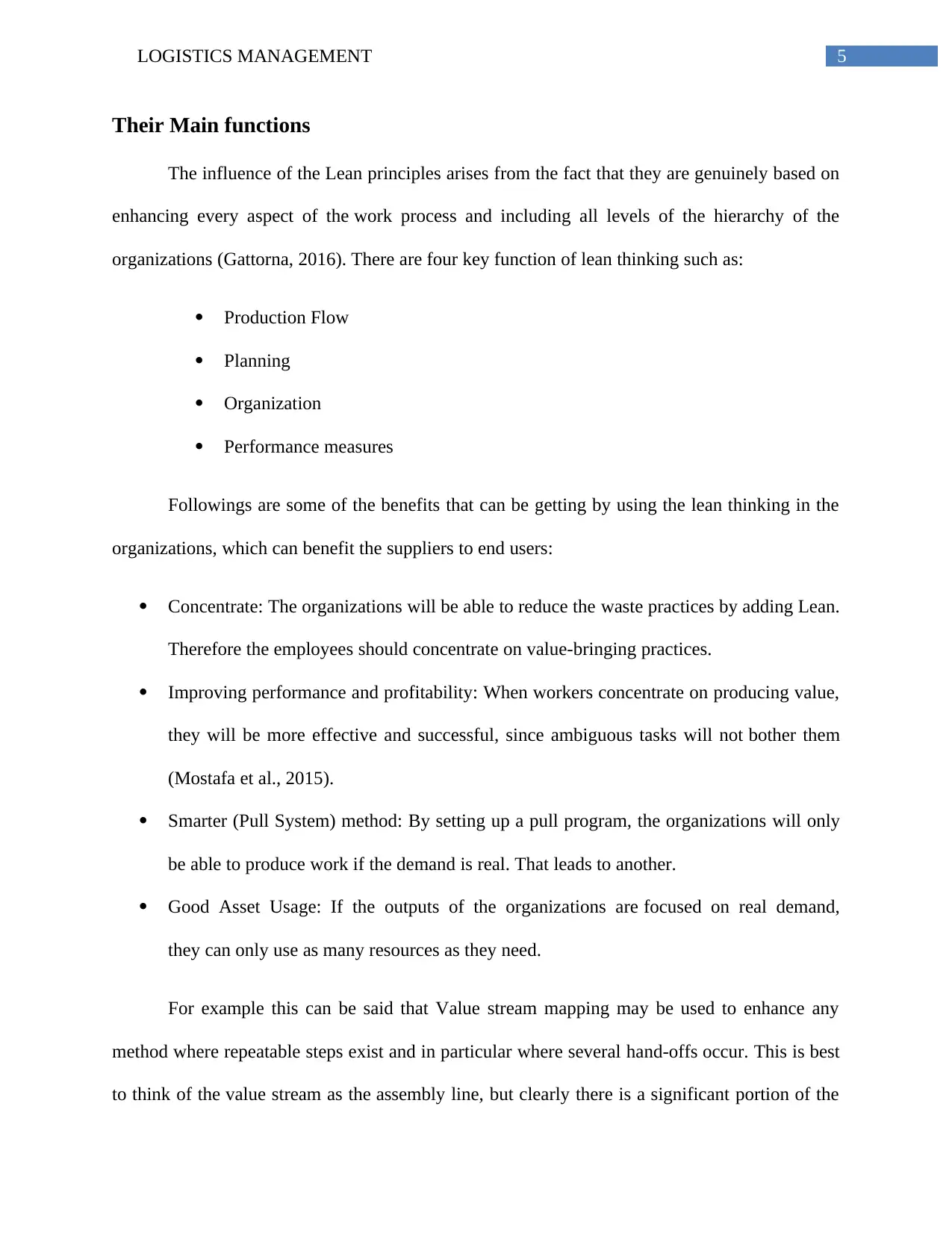
5LOGISTICS MANAGEMENT
Their Main functions
The influence of the Lean principles arises from the fact that they are genuinely based on
enhancing every aspect of the work process and including all levels of the hierarchy of the
organizations (Gattorna, 2016). There are four key function of lean thinking such as:
Production Flow
Planning
Organization
Performance measures
Followings are some of the benefits that can be getting by using the lean thinking in the
organizations, which can benefit the suppliers to end users:
Concentrate: The organizations will be able to reduce the waste practices by adding Lean.
Therefore the employees should concentrate on value-bringing practices.
Improving performance and profitability: When workers concentrate on producing value,
they will be more effective and successful, since ambiguous tasks will not bother them
(Mostafa et al., 2015).
Smarter (Pull System) method: By setting up a pull program, the organizations will only
be able to produce work if the demand is real. That leads to another.
Good Asset Usage: If the outputs of the organizations are focused on real demand,
they can only use as many resources as they need.
For example this can be said that Value stream mapping may be used to enhance any
method where repeatable steps exist and in particular where several hand-offs occur. This is best
to think of the value stream as the assembly line, but clearly there is a significant portion of the
Their Main functions
The influence of the Lean principles arises from the fact that they are genuinely based on
enhancing every aspect of the work process and including all levels of the hierarchy of the
organizations (Gattorna, 2016). There are four key function of lean thinking such as:
Production Flow
Planning
Organization
Performance measures
Followings are some of the benefits that can be getting by using the lean thinking in the
organizations, which can benefit the suppliers to end users:
Concentrate: The organizations will be able to reduce the waste practices by adding Lean.
Therefore the employees should concentrate on value-bringing practices.
Improving performance and profitability: When workers concentrate on producing value,
they will be more effective and successful, since ambiguous tasks will not bother them
(Mostafa et al., 2015).
Smarter (Pull System) method: By setting up a pull program, the organizations will only
be able to produce work if the demand is real. That leads to another.
Good Asset Usage: If the outputs of the organizations are focused on real demand,
they can only use as many resources as they need.
For example this can be said that Value stream mapping may be used to enhance any
method where repeatable steps exist and in particular where several hand-offs occur. This is best
to think of the value stream as the assembly line, but clearly there is a significant portion of the
⊘ This is a preview!⊘
Do you want full access?
Subscribe today to unlock all pages.

Trusted by 1+ million students worldwide
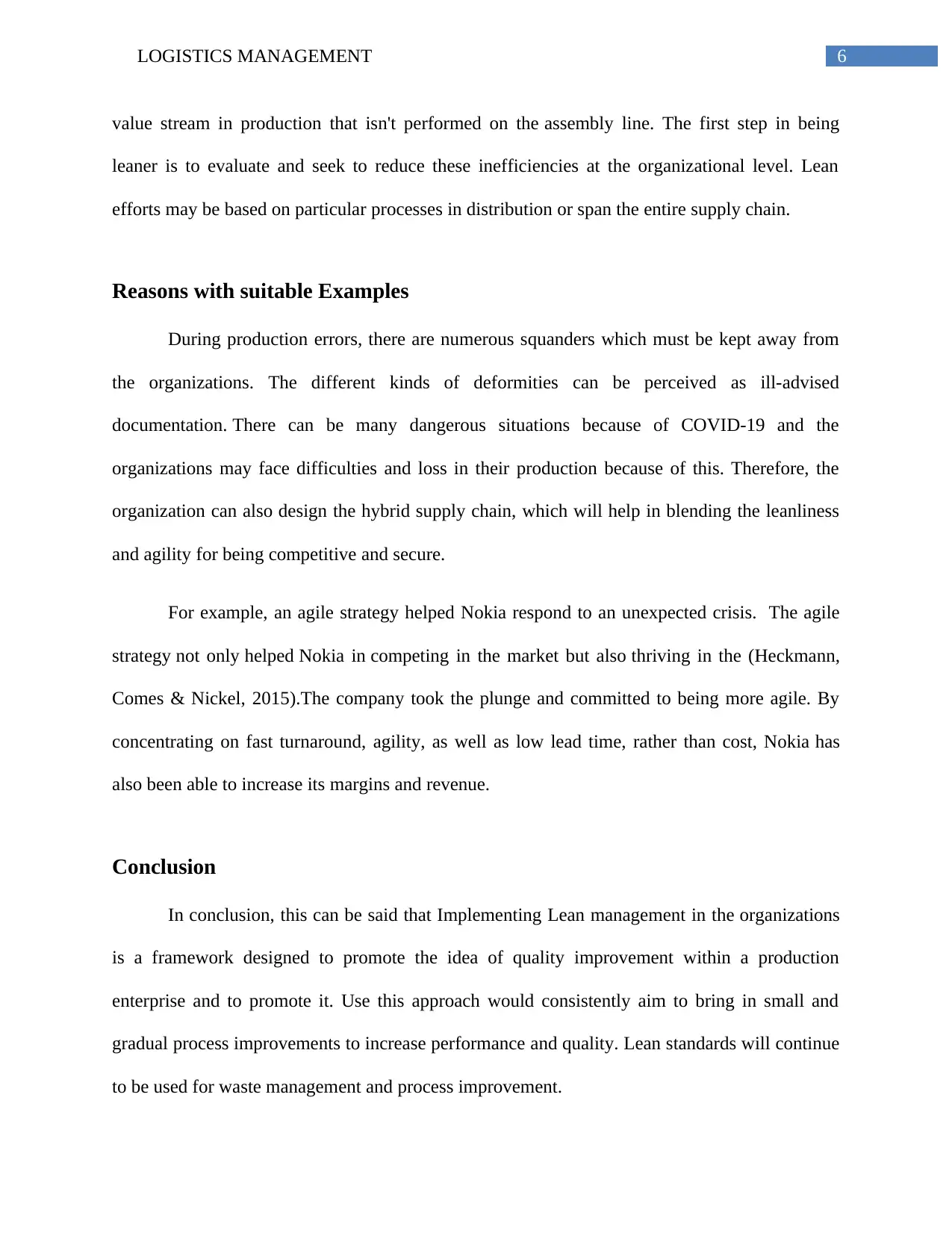
6LOGISTICS MANAGEMENT
value stream in production that isn't performed on the assembly line. The first step in being
leaner is to evaluate and seek to reduce these inefficiencies at the organizational level. Lean
efforts may be based on particular processes in distribution or span the entire supply chain.
Reasons with suitable Examples
During production errors, there are numerous squanders which must be kept away from
the organizations. The different kinds of deformities can be perceived as ill-advised
documentation. There can be many dangerous situations because of COVID-19 and the
organizations may face difficulties and loss in their production because of this. Therefore, the
organization can also design the hybrid supply chain, which will help in blending the leanliness
and agility for being competitive and secure.
For example, an agile strategy helped Nokia respond to an unexpected crisis. The agile
strategy not only helped Nokia in competing in the market but also thriving in the (Heckmann,
Comes & Nickel, 2015).The company took the plunge and committed to being more agile. By
concentrating on fast turnaround, agility, as well as low lead time, rather than cost, Nokia has
also been able to increase its margins and revenue.
Conclusion
In conclusion, this can be said that Implementing Lean management in the organizations
is a framework designed to promote the idea of quality improvement within a production
enterprise and to promote it. Use this approach would consistently aim to bring in small and
gradual process improvements to increase performance and quality. Lean standards will continue
to be used for waste management and process improvement.
value stream in production that isn't performed on the assembly line. The first step in being
leaner is to evaluate and seek to reduce these inefficiencies at the organizational level. Lean
efforts may be based on particular processes in distribution or span the entire supply chain.
Reasons with suitable Examples
During production errors, there are numerous squanders which must be kept away from
the organizations. The different kinds of deformities can be perceived as ill-advised
documentation. There can be many dangerous situations because of COVID-19 and the
organizations may face difficulties and loss in their production because of this. Therefore, the
organization can also design the hybrid supply chain, which will help in blending the leanliness
and agility for being competitive and secure.
For example, an agile strategy helped Nokia respond to an unexpected crisis. The agile
strategy not only helped Nokia in competing in the market but also thriving in the (Heckmann,
Comes & Nickel, 2015).The company took the plunge and committed to being more agile. By
concentrating on fast turnaround, agility, as well as low lead time, rather than cost, Nokia has
also been able to increase its margins and revenue.
Conclusion
In conclusion, this can be said that Implementing Lean management in the organizations
is a framework designed to promote the idea of quality improvement within a production
enterprise and to promote it. Use this approach would consistently aim to bring in small and
gradual process improvements to increase performance and quality. Lean standards will continue
to be used for waste management and process improvement.
Paraphrase This Document
Need a fresh take? Get an instant paraphrase of this document with our AI Paraphraser
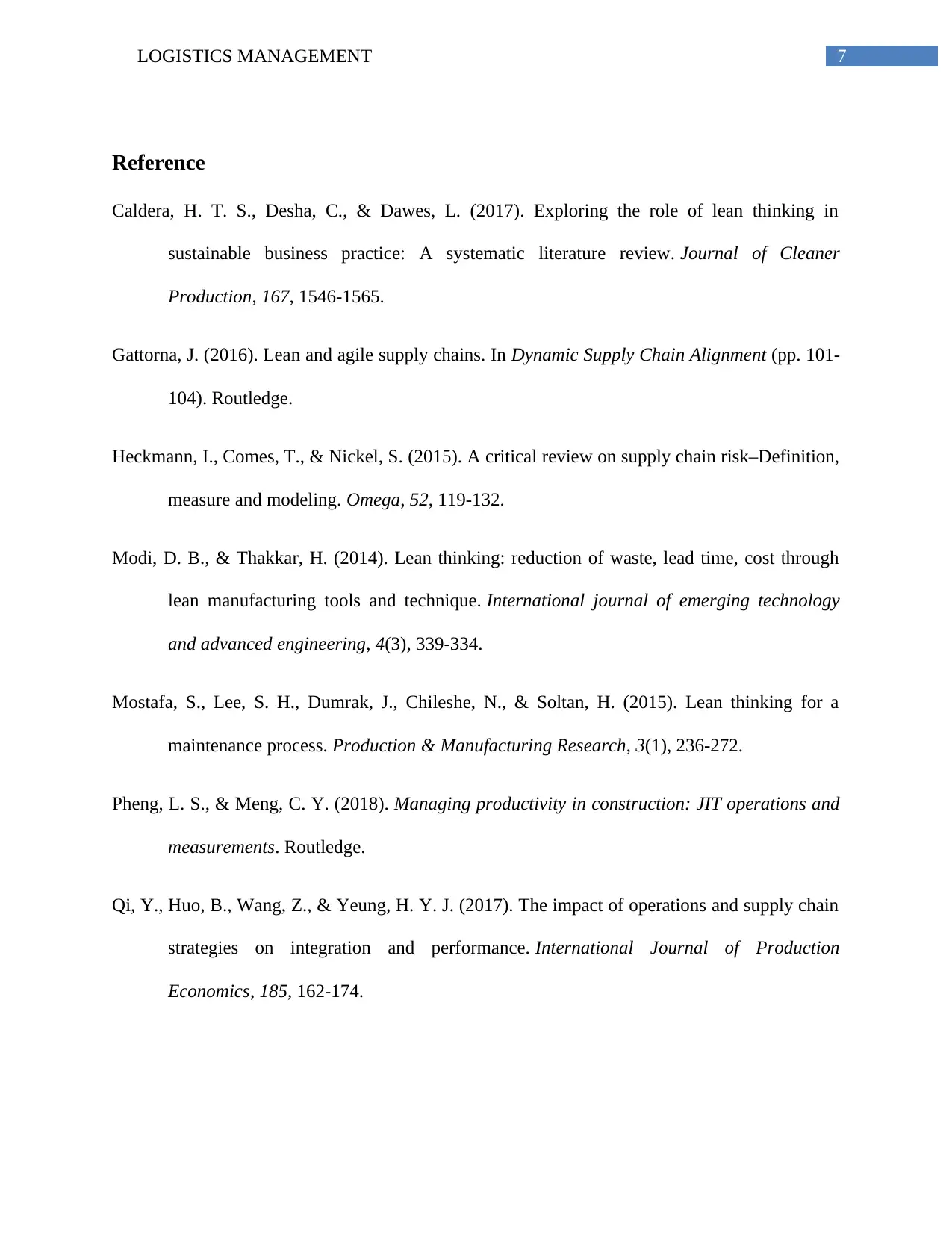
7LOGISTICS MANAGEMENT
Reference
Caldera, H. T. S., Desha, C., & Dawes, L. (2017). Exploring the role of lean thinking in
sustainable business practice: A systematic literature review. Journal of Cleaner
Production, 167, 1546-1565.
Gattorna, J. (2016). Lean and agile supply chains. In Dynamic Supply Chain Alignment (pp. 101-
104). Routledge.
Heckmann, I., Comes, T., & Nickel, S. (2015). A critical review on supply chain risk–Definition,
measure and modeling. Omega, 52, 119-132.
Modi, D. B., & Thakkar, H. (2014). Lean thinking: reduction of waste, lead time, cost through
lean manufacturing tools and technique. International journal of emerging technology
and advanced engineering, 4(3), 339-334.
Mostafa, S., Lee, S. H., Dumrak, J., Chileshe, N., & Soltan, H. (2015). Lean thinking for a
maintenance process. Production & Manufacturing Research, 3(1), 236-272.
Pheng, L. S., & Meng, C. Y. (2018). Managing productivity in construction: JIT operations and
measurements. Routledge.
Qi, Y., Huo, B., Wang, Z., & Yeung, H. Y. J. (2017). The impact of operations and supply chain
strategies on integration and performance. International Journal of Production
Economics, 185, 162-174.
Reference
Caldera, H. T. S., Desha, C., & Dawes, L. (2017). Exploring the role of lean thinking in
sustainable business practice: A systematic literature review. Journal of Cleaner
Production, 167, 1546-1565.
Gattorna, J. (2016). Lean and agile supply chains. In Dynamic Supply Chain Alignment (pp. 101-
104). Routledge.
Heckmann, I., Comes, T., & Nickel, S. (2015). A critical review on supply chain risk–Definition,
measure and modeling. Omega, 52, 119-132.
Modi, D. B., & Thakkar, H. (2014). Lean thinking: reduction of waste, lead time, cost through
lean manufacturing tools and technique. International journal of emerging technology
and advanced engineering, 4(3), 339-334.
Mostafa, S., Lee, S. H., Dumrak, J., Chileshe, N., & Soltan, H. (2015). Lean thinking for a
maintenance process. Production & Manufacturing Research, 3(1), 236-272.
Pheng, L. S., & Meng, C. Y. (2018). Managing productivity in construction: JIT operations and
measurements. Routledge.
Qi, Y., Huo, B., Wang, Z., & Yeung, H. Y. J. (2017). The impact of operations and supply chain
strategies on integration and performance. International Journal of Production
Economics, 185, 162-174.

8LOGISTICS MANAGEMENT
Tarafdar, M., & Qrunfleh, S. (2017). Agile supply chain strategy and supply chain performance:
complementary roles of supply chain practices and information systems capability for
agility. International Journal of Production Research, 55(4), 925-938.
Tarafdar, M., & Qrunfleh, S. (2017). Agile supply chain strategy and supply chain performance:
complementary roles of supply chain practices and information systems capability for
agility. International Journal of Production Research, 55(4), 925-938.
⊘ This is a preview!⊘
Do you want full access?
Subscribe today to unlock all pages.

Trusted by 1+ million students worldwide
1 out of 9
Related Documents
Your All-in-One AI-Powered Toolkit for Academic Success.
+13062052269
info@desklib.com
Available 24*7 on WhatsApp / Email
![[object Object]](/_next/static/media/star-bottom.7253800d.svg)
Unlock your academic potential
Copyright © 2020–2025 A2Z Services. All Rights Reserved. Developed and managed by ZUCOL.




